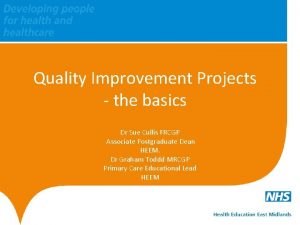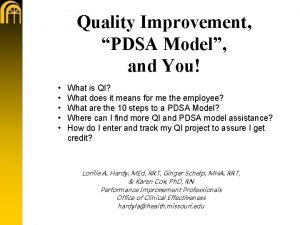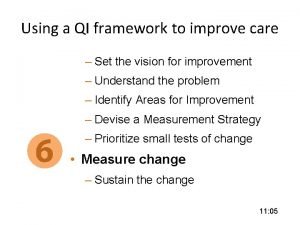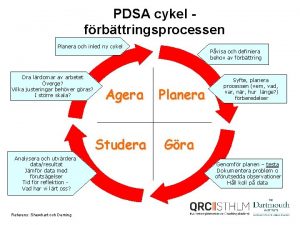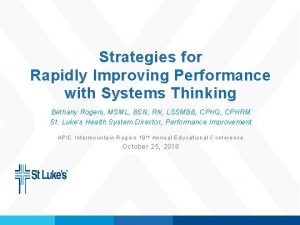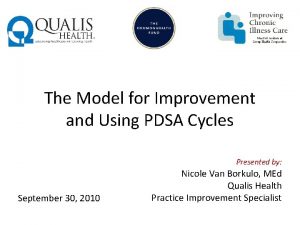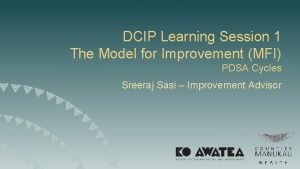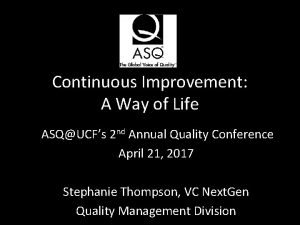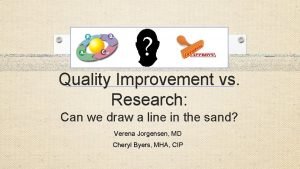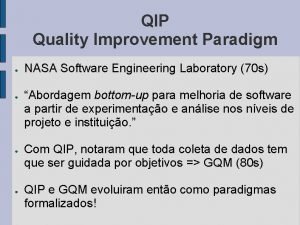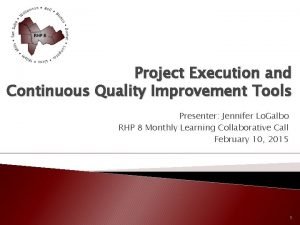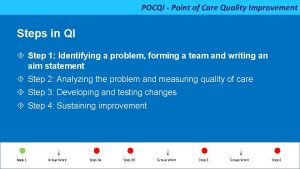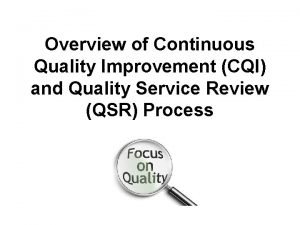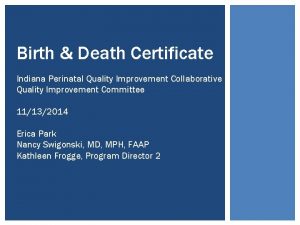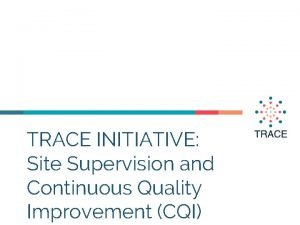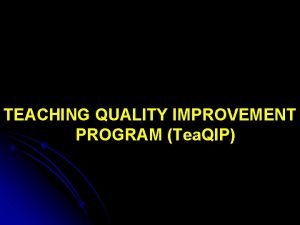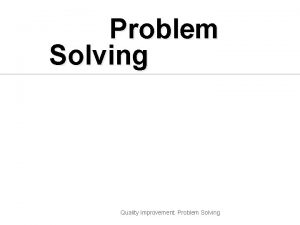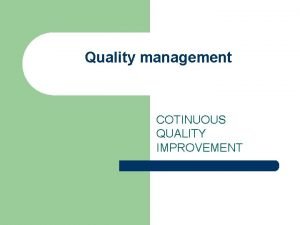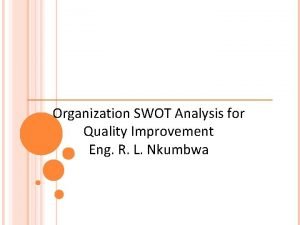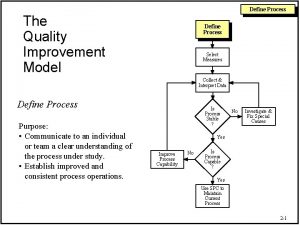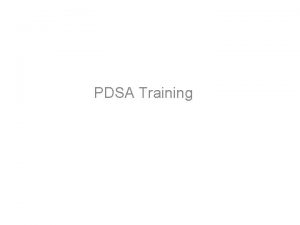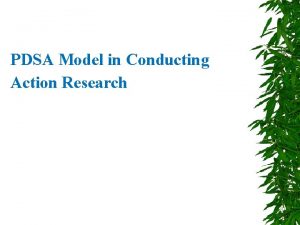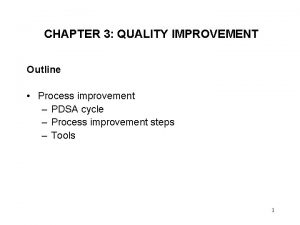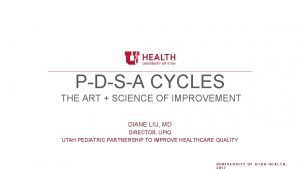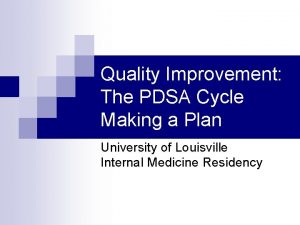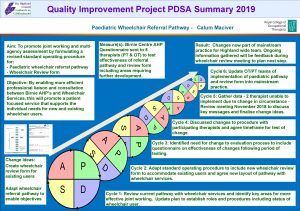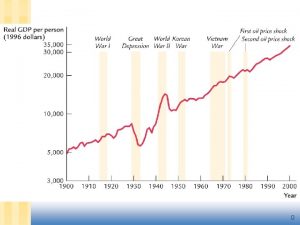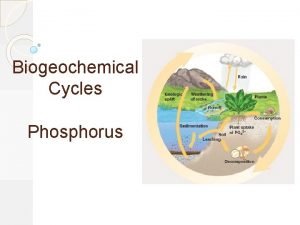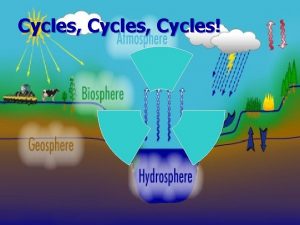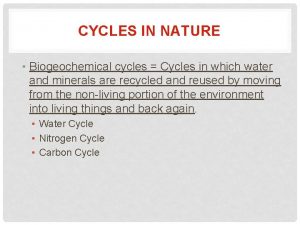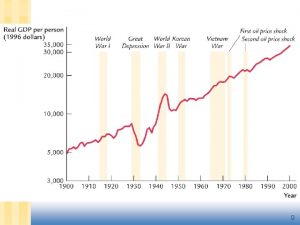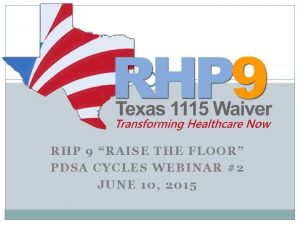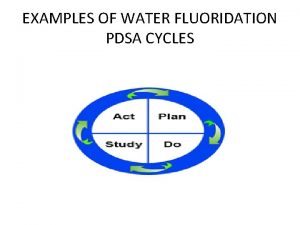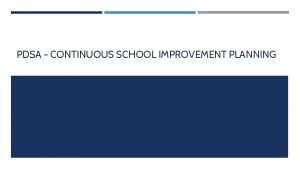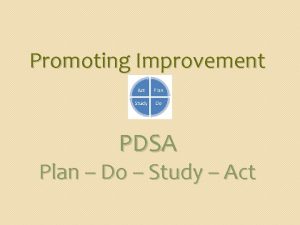Quality Improvement The Model for Improvement PDSA Cycles





































- Slides: 37

Quality Improvement The Model for Improvement, PDSA Cycles, and Accelerating Improvement

Session Objectives • To describe the components of the Model for Improvement • To identify measures and goals for your participation in EASE • To develop a clear plan for your team to test a change idea • To identify future tests of change

QUALITY IMPROVEMENT STRUCTURE, APPROACH AND ROADMAP

Structure is Based on Institute for Healthcare Improvement (IHI) Breakthrough Series • • Select a Quality Improvement Topic Conduct Expert Meeting Planning Group (Experts) Develop Framework and Changes Spread and Dissemination Participants (YOU!) Learning Session Supports: Experts Learning Session Action Period Calls Telephone Email Monthly Reports Monthly Data Action Period Calls Holding the Gains

Approach is Based on The Model for Improvement What are we trying to accomplish? How will we know that a change is an improvement? What change can we make that will result in improvement? The Improvement Guide Associates in Process Improvement Act Plan Study Do


Key Driver Diagram Medical Directors: Sarah Denny, MD, FAAP and Michael Gittelman, MD, FAAP Principal Investigator: Jamie Macklin, MD, FAAP Updated: June 8, 2015 INTERVENTIONS SMART AIM By April 30, 2016, at least 80% of children less than 1 year of age who are sleeping at a participating Ohio hospital, will be found in a “safe sleep” position on random weekly audits. A “safe sleep” position includes: • Sleeping in his/her own crib • Laying on his/her back • The crib is bare except for a fitted sheet (no blankets present) GLOBAL AIM KEY DRIVERS Nursing Education Multi-Disciplinary (PCA, OT/PT) Education • • CHEX Quality Board Tips Nurse champions/RN care partners Scripting for – and with – parents Safe Sleep “Cheat Sheet” • Grand Rounds • Hospital pediatricians web module Physician Education Parent/Caregiver Education Management of Environment Provide children with the opportunity to grow up to reach their fullest potential by eliminating death or injury due to unsafe sleep habits. Key Driver Diagram adapted from Nationwide Children’s Hospital • • Safety Videos/Edutainment System Take-home magnets Brochures Safe Sleep posters • Sleep sacks • Safe Sleep Policy developed • Assess hospital policy on clothing allowed for patients • Mattresses on beds need evaluated • Potentially use fitted sheets on beds

THE MODEL FOR IMPROVEMENT

The Model for Improvement Part 1: Answers these three questions What are we trying to accomplish? How will we know that a change is an improvement? What change can we make that will result in improvement? Part 2: Guides change to see if there is an improvement The Improvement Guide Associates in Process Improvement Act Plan Study Do

The Model for Improvement Part 1: Answers these three questions What are we trying to accomplish? How will we know that a change is an improvement? What change can we make that will result in improvement? Part 2: Guides change to see if there is an improvement The Improvement Guide Associates in Process Improvement Act Set Aims Establish Measures Select Changes Plan Test the Changes Study Do

The Model for Improvement What are we trying to accomplish? How will we know that a change is an improvement? What change can we make that will result in improvement? The Improvement Guide Associates in Process Improvement Act Plan Study Do Aim

Why a Project AIM Statement? • Answers and clarifies “What are we trying to accomplish? ” • Creates a shared language to communicate about the project • Facilitates organizational conversations and understanding • Provides a basis for developing the rest of the project (measures and changes)

Aim Statements • Provides a focused rationale and vision for what your team plans to accomplish • Are SMART S: Specific M: Measurable A: Action-Oriented R: Relevant/Realistic T: Timely

Key Driver Diagram Medical Directors: Sarah Denny, MD, FAAP and Michael Gittelman, MD, FAAP Principal Investigator: Jamie Macklin, MD, FAAP Updated: June 8, 2015 INTERVENTIONS SMART AIM By April 30, 2016, at least 80% of children less than 1 year of age who are sleeping at a participating Ohio hospital, will be found in a “safe sleep” position on random weekly audits. A “safe sleep” position includes: • Sleeping in his/her own crib • Laying on his/her back • The crib is bare except for a fitted sheet (no blankets present) GLOBAL AIM KEY DRIVERS Nursing Education Multi-Disciplinary (PCA, OT/PT) Education • • CHEX Quality Board Tips Nurse champions/RN care partners Scripting for – and with – parents Safe Sleep “Cheat Sheet” • Grand Rounds • Hospital pediatricians web module Physician Education Parent/Caregiver Education Management of Environment Provide children with the opportunity to grow up to reach their fullest potential by eliminating death or injury due to unsafe sleep habits. Key Driver Diagram adapted from Nationwide Children’s Hospital • • Safety Videos/Edutainment System Take-home magnets Brochures Safe Sleep posters • Sleep sacks • Safe Sleep Policy developed • Assess hospital policy on clothing allowed for patients • Mattresses on beds need evaluated • Potentially use fitted sheets on beds

The Model for Improvement What are we trying to accomplish? How will we know that a change is an improvement? What change can we make that will result in improvement? The Improvement Guide Associates in Process Improvement Act Plan Study Do Measures

Why do we measure? Measures facilitate learning and are not for judgment or comparison – Recognize areas for improvement • Define the gap between where we are and where we need to be – Provide feedback as a means to evaluate • Are the changes we’re making having the desired impact? – Characterize the robustness of change • How does our system respond to the changes we’ve made?

Measurement Assumptions • The purpose of measurement is for learning, not judgment. • All measures have limitations, but the limitations do not negate all value. • Measures are one voice of the system. Hearing the voice of the system gives us information on how to act with and within the system. • Measures tell a story; goals give a reference point.

Three Types of Measures • Outcome Measures: Voice of the customer or patient. How is the system performing? What is the result? • Process Measures: Voice of the workings of the system. Are the parts/steps in the system performing as planned? • Balancing Measures: Looking at a system from different directions/dimensions. What happened to the system as we improved the outcome and process measures (e. g. unanticipated consequences, other factors influencing outcome)?

EASE Measures EASE process measures include: • > 90% of patients 1 year of age and younger will leave the hospital with information on safe sleep practices • Each hospital will show that > 80% of children ≤ 1 year of age will be in “safe sleep” position (own crib, nothing in crib and on back) on random weekly audits by the end of the 12 -month project – This is a bundled measure of all three items for a safe sleep position

The Model for Improvement What are we trying to accomplish? How will we know that a change is an improvement? What change can we make that will result in improvement? The Improvement Guide Associates in Process Improvement Act Plan Study Do Ideas/ Changes

The Model for Improvement What are we trying to accomplish? How will we know that a change is an improvement? What change can we make that will result in improvement? The Improvement Guide Associates in Process Improvement Act Plan Study Do P-D-S-A Cycle

PLAN – DO – STUDY – ACT CYCLES

The PDSA Cycle Four Steps: Plan, Do, Study, Act Also known as: • Shewhart Cycle Act Plan Study Do • Deming Cycle • Learning and Improvement Cycle The Improvement Guide Associates in Process Improvement

Use PDSA Cycles for: • Testing or adapting a change idea – May answer a question related to the aim • Implementing a change • Spreading the changes to the rest of the system

Why Test? • Force us to think small • Increases your belief that the change will result in improvement • Opportunity for learning without impacting performance • Help teams adapt good ideas to their specific situation The Improvement Guide Associates in Process Improvement

Key Points for PDSA Cycles • Do initial cycles on smallest scale possible – Think baby steps…a “cycle of one” usually best • “Failures” are good learning opportunities; can be better than “Successes” • As move to implementation, test under as many conditions as possible – Think about factors that could lead to breakdowns, supports needed, “naysayers” – Different providers; different days of the week; different patient populations, etc.

Key Points for PDSA Cycles • Do initial cycles on smallest scale and within shortest timeframe possible - Think baby steps…a “cycle of one” usually best Ø Ø Ø Ø Years Quarters Months Weeks Days Hours Minutes Drop down “two levels” to plan Test Cycle!

Common PDSA Pitfalls 1. Testing changes where link to overall aim or key driver is unclear 2. Failing to make a prediction before testing the change 3. Failing to execute the whole cycle – Plan, Plan-D-S-A (too much planning, not enough doing) – P-Do, Do-S-A (too much doing, not enough studying)

Common PDSA Pitfalls 4. Not learning from “failures” 5. Lack of detailed execution plan 6. Failure to think ahead a few cycles



PDSA Cycle Ramps: Sequential Building of Knowledge Successive tests of a change build knowledge AND create a ramp to improvement A P A T A D A S Best Practice A P Evidence S D Hunches Theories Testable Very Small Ideas Scale Test Changes That Result in Improvement S D D S P A P D Follow-up Tests Implementation of Change Wide-Scale Tests of Change The Improvement Guide Associates in Process Improvement

Example of Accelerating Improvement Plan Act TEST 1 What: Provide maps Who (population): Day drivers Where: Clifton location When: From 1/2 to 1/5 Who Executes: Mgr. Joe Results: Nobody got lost Study TEST 2 What: Provide maps Who (population): all shifts Where: Clifton location When: From 1/6 to 1/13 Who Executes: Mgr. Joe Results: Nobody got lost but deliveries took longer & some drivers had difficulty using the Study Do Do TEST 3 What: Mapquest Directions Who (population): Day drivers Where: Clifton location When: From 1/14 to 1/17 Who Executes: Mgr. Joe Results: Nobody got lost, directions easier than map but printing out & sorting directions takes time TEST 4 What: Mapquest Directions Who (population): all shifts Where: Clifton location When: From 1/17 to 1/24 Who Executes: Mgr. Joe Results: Nobody got lost, directions easier than map, but printing and sorting directions still took time; suggested telephone answerer device plan for printing/sorting maps for drivers

“All improvements requires change, but not every change is improvement. ” The Improvement Guide, 2009

Quality Improvement Videos • The Model for Improvement: http: //www. youtube. com/watch? v=SCYgh xtio. IY • PDSA Cycles: http: //www. youtube. com/watch? v=_ce. S 9 Ta 820&feature=youtu. be

References Fuller, S. (2010). Model for Improvement. Power. Point slides Griffin, F. (2004). The PDSA Cycle Testing and Implementing Changes. Retrieved from: www. njha. com/qualityinstitute/pdf/628200432756 PM 63. ppt · PPT file Langley, G. , Moen, R. , Nolan, K. , Nolan T. , Norman, Provost, L. (2009). The Improvement Guide: A Practical Approach to Enhancing Organizational Performance. 2 nd edition. Jossey-Bass Publishers. , San Francisco. Moen, R. and Norman, C. (2010). Circling back clearing up myths about the Deming cycle and seeing how it keeps evolving. Retrieved from www. qualityprogress. com NHS Institute for Innovation and Improvement. Quality and Service Improvement Tools: PDSA. Retrieved fromhttp: //www. institute. nhs. uk/quality_and_service_improvement_tools/quality_and_service_improvement _tools/plan_do_study_act. html Provost, L. , Murray, S. (2011). The Health Care Data Guide: Learning from data for Improvement. Jossey-Bass Publishers. , San Francisco. Society of Hospital Medicine. Plan-Do- Study- Act. Retrieved from: http: //www. hospitalmedicine. org/Resource. Room. Redesign/CSSSIS/html/06 Reliable/Plan_study. cfm The Model for Improvement National Primary Care Development Team (2004). Retrieved from: www. npdt. org

Questions to Consider: 1. Do any of our team members need additional QI or PDSA training? 2. What Key Drivers will affect our changes?
 Model for improvement
Model for improvement Siklus pdsa
Siklus pdsa Quality assurance cycle in nursing
Quality assurance cycle in nursing Compliance vs quality
Compliance vs quality Pdsa model nhs
Pdsa model nhs Pdsa model nhs
Pdsa model nhs Pdsa model
Pdsa model Pdsa worksheet
Pdsa worksheet Rampa de pdsa
Rampa de pdsa Pdsa-cykeln
Pdsa-cykeln Jens bejer damgaard
Jens bejer damgaard Pdsa sirkel
Pdsa sirkel Pdsa exemplo
Pdsa exemplo Pdsa cycle in healthcare
Pdsa cycle in healthcare Pdsa sirkel
Pdsa sirkel Pdsa
Pdsa Pdsa falkirk
Pdsa falkirk Pdsa
Pdsa Ucf pdsa
Ucf pdsa Jhm irb
Jhm irb What is qsen
What is qsen Quality improvement paradigm
Quality improvement paradigm Continuous quality improvement plan example
Continuous quality improvement plan example Point of care quality improvement
Point of care quality improvement Define continuous quality improvement
Define continuous quality improvement Efmd quality improvement system
Efmd quality improvement system Indiana perinatal quality improvement collaborative
Indiana perinatal quality improvement collaborative Continuous quality improvement program planning worksheet
Continuous quality improvement program planning worksheet Tea quality improvement
Tea quality improvement Quality improvement
Quality improvement Sus qi
Sus qi Quality improvement nurse
Quality improvement nurse Quality improvement
Quality improvement Juran 10 steps to quality improvement
Juran 10 steps to quality improvement Swot analysis for quality
Swot analysis for quality Malnutrition quality improvement initiative
Malnutrition quality improvement initiative Quality improvement
Quality improvement Data driven quality improvement
Data driven quality improvement




